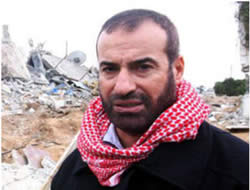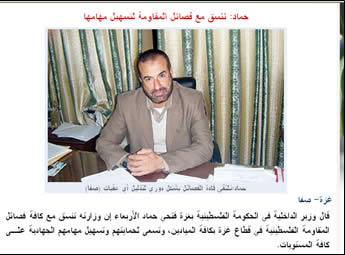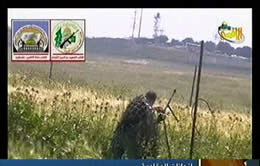http://www.terrorism-info.org.il/en/article/20499

1. Since the end of Operation Pillar of Defense (November 2012) Hamas operatives in the Gaza Strip led by Fathi Hamad, minister of the interior of the Hamas administration, have increased their efforts to establish terrorist squads in Judea and Samaria to carry out attacks against Israel. Among the planned attacks were suicide bombing attacks, the abduction of IDF soldiers and Israeli civilians, and killing attacks. On the other hand, since the end of Operation Pillar of Defense Hamas has been careful to preserve the lull in the fighting, and has made an effort to enforce its policy on the rogue terrorist organizations operating in the Gaza Strip. Fathi Hamad plays a role in both aspects of Hamas policy as he is in change of the security services of the de facto Hamas administration.
2. Early in 2013 the Israeli security services exposed a Hamas squad from the Silwad and Ras Karkar regions in Judea (north and west of Ramallah). They were planning a variety of terrorist attacks, including detonating IEDs, abducting an IDF soldier or Israeli resident of Judea or Samaria, and firing improvised rockets. They maintained contact with the Gaza Strip via the Internet and telephone, and received instructions for making weapons. Regarding the abduction of an Israeli soldier, they were specifically instructed to take his weapon, cell phone and ID for purposes of identification during negotiations, and then to kill him and hide his body. At the time of their capture, they had completed their plans and had informed the Gaza Strip that they were prepared to carry out an attack within a number of days (Israel Security Agency website, March 2013).
3. The terrorist network exposed in Judea and Samaria was in contact with close aides of Fathi Hamad, minister of the interior in the de-facto Hamas administration in the Gaza Strip. Since the end of Operation Pillar of Defense Fathi Hamad has been involved in attempts to carry out particularly brazen terrorist attacks from Judea and Samaria through his aides, Hamas operatives and a terrorist organization calling itself “The Defenders of Al-Aqsa,” which operates under his patronage (Israel Security Agency website, March 2013).
|
4. As minister of the interior, Fathi Hamad is responsible for the security services which enforce the lull in the fighting achieved at the end of Operation Pillar of Defense. The exposure of his involvement in directing terrorist attacks in Judea and Samaria again reveals his double role as both a handler of terrorist squads and enforcer of Hamas’ policy of restraint. In addition, for years there has been close collaboration between the security services he heads and the Izz al-Din al-Qassam Brigades, Hamas’ military-terrorist wing. |

Heading: “[Fathi] Hamad: We are collaborating with the resistance factions [i.e., the terrorist organizations] to make it easier for them to carry out their missions.” Caption: Hamad says that his ministry coordinates with all the factions of the Palestinian resistance in the Gaza Strip. [His ministry] seeks to protect them and make their jihad missions easier to carry out” (Safa News Agency website, October 28, 2009).
Role of Fathi Hamad and the Hamas Security Services in Lull Enforcement and Terrorist Activity
5. After Hamas took over the Gaza Strip in June 2007 it established an extensive network of internal security services loyal to the de facto administration. The security services are responsible for implementing Hamas’ internal policies and enforcing its control over the Gaza Strip. The various security services repress political opposition, deal with hostility from the local population, enforce Hamas’ growing Islamization of the Gaza Strip and preserve public order. While the Hamas administration’s ministry of the interior and national security controls internal security, it is also an integral part of Hamas’ military apparatus. It maintains close operational collaboration with the Izz al-Din al-Qassam Brigades, Hamas’ military-terrorist wing, a situation clearly manifested during Operation Cast Lead.
6. Since Operation Pillar of Defense the internal security services headed by Fathi Hamad have been responsible for enforcing the lull in the fighting and preventing the rogue terrorist organizations operating in the Gaza Strip from attacking Israel. At the same time he initiates covert military-terrorist activity. One of his terrorist proxies is a front organization established by Hamas called “The Defenders of Al-Aqsa,” which has initiated low-signature attacks against Israel. For example, the organization was responsible for the February 21, 2012 placing of an IED on the Israeli-Egyptian border in the region between Kerem Shalom and Nitzana.[1] Moreover, Fathi Hamad handles terrorist squads in Judea and Samaria, as revealed by the interrogation of the Hamas operatives from the Silwad- Ras Karkar area (west and north of Ramallah).
|
7.In addition for years there has been close cooperation between the Hamas police and other internal security services on the one hand, and Hamas’ military-terrorist wing (the Izz al-Din al-Qassam Brigades) on the other. The cooperation has been manifested by mutual deployment and training, sharing logistics and intelligence, carrying out joint ambushes and surveillance, and integrating the internal security services into the fighting against the IDF in emergency situations.[2] |
8. One manifestation of the collaboration between the security services and the Izz al-Din al-Qassam Brigades is the custom of having both groups issue death notices when an operative dies as a shaheed in an anti-Israeli activity. For example, during Operation Cast Lead and Operation Pillar of Defense obituaries of operatives were posted by both the Hamas police force and other internal security services and Hamas’ military-terrorist wing. Fathi Hamad boasted that his ministry made efforts to protect the various terrorist organizations and to “make it easier for them to carry out jihad missions” (See below) (Safa News Agency, October 28, 2009). Fathi Hamad also noted the “achievements” of his predecessor, Said Siyam, saying that “one of his greatest achievements was initiating the collaboration between the present security services and the Palestinian resistance [i.e., terrorist organizations]…against the Zionist enemy…and that was why [the Zionist enemy] bombed the security services’ headquarters [during Operation Cast Lead] (Website of the Hamas police, May 7, 2009).
“The Defenders of Al-Aqsa”
9. Most of the information about “The Defenders of Al-Aqsa” comes from the interrogation of Ayub Azzam Ahmed, aka Abu Karim, a Hamas military-terrorist operative from the Al-Maghazi refugee camp in the central Gaza Strip, who was involved in dozens of terrorist attacks against Israel. During interrogation he revealed that “The Defenders of Al-Aqsa” was a front organization handled by Hamas and its objective was to carry out low-signature terrorist attacks against Israel (i.e., attacks in which Hamas involvement would not be apparent). He said the organization was headed by Muhammad Subhi Abd al-Rahim Tamraz, from the Jabaliya refugee camp (Israel Security Agency, May 4, 2011).
10. The interrogation of Ayub Azzam Ahmed also revealed that the organization was established and funded by Fathi Hamad. He said that the organization’s leadership received all its instructions for military actions directly from Hamas. One of its attacks was the shooting at motorcade of the Israeli minister of internal security near the Israeli village of Nir Am in April 2008.[3] The interrogation also revealed that the main goal in establishing the organization was to carry out terrorist attacks against Israel. That would provide Hamas with cover and operational flexibility to act against Israel while responsibility for the attacks would be claimed by a “rogue” organization (Israel Security Agency website, May 4, 2011).

A Palestinian sniper shoots at the Israeli minister of internal security’s motorcade. The logos at the upper left are of the Izz al-Din al-Qassam Brigades and “The Defenders of Al-Aqsa,” which claimed joint responsibility for the attack (Al-Aqsa TV, April 4, 2008).
Appendix
Portrait of Fathi Hamad
1. Fathi Hamad was born in the Jabaliya refugee camp in the Gaza Strip in 1961, and has lived there his entire life. He is married to three women. One of his wives is the sister of Muhammad Nasser, one of the murderers of the IDF soldier Ilan Saadon.
2. In April 2010 Fathi Hamad’s three year-old daughter was treated at the Israeli hospital in Ashqelon after heart surgery performed in Jordan failed and her life was in danger. After being treated in the hospital, which was arranged through the intercession of the Israeli prime minister and minister of defense, she was flown to a hospital in Amman, the capital of Jordan.[4] Hamas was careful to hide the incident behind a wall of censorship (Israel Channel 2 news, April 25, 2010).
3. In 2006 Fathi Hamad was elected to the Palestinian Legislative Council as the Hamas representative from Beit Lahia. He was also one of the three Palestinians authorized by Hamas to participate in the negotiations for the prisoner exchange deal that led to the liberation of abducted Israeli soldiers Gilad Shalit. Several times he threatened to abduct Israeli soldiers to secure the release of Palestinian operatives imprisoned in Israeli jails. On April 26, 2009, he was officially appointed minister of the interior of the de-facto Hamas administration after the previous minister, Said Siyam, was killed during Operation Cast Lead. One of his functions as minister is responsibility for the police force and other internal security services.
4. Fathi Hamad is one of the most extremist figures in Hamas, close to the Izz al-Din al-Qassam Brigades and a bitter Fatah rival. However, he is close personal friend of Sufian Abu Zaida, whom he has known since childhood, and who represents Fatah in the Palestinian Legislative Council (Ynet, April 12, 2010).
Statements Made by Fathi Hamad
5. The following are some of the statements made by Fathi Hamad:
1) In a speech made in February 2008 he said that the Palestinian people had developed their own methods of killing. He said that for the Palestinians death had become an “industry” that women excelled in. The Palestinian people, he said, had turned women, children and the aged into human shields to challenge the Israeli bomb machine (Al-Aqsa TV, February 2008). The spech was quoted by the Goldstone Report.
2) Appointed to the post of Hamas minister of the interior, he said that the goal of the ministry would remain “the preservation of the option of jihad and resistance [i.e., terrorism and violence],” as opposed to Fatah, whose security services “fought the resistance and conducted security collaboration with the enemy” (Fathi Hamad interviewed by the Hamas ministry of information; the interview was posted on Hamas’ PALDF forum, May 6, 2009). In a different interview he noted the important achievements of his predecessor, Said Siyam, saying that one of his greatest accomplishments was instituting collaboration and coordination between the security services and the Palestinian resistance [i.e., terrorist organizations]. He said the collaboration did not please the “Zionist enemy,” which was why it had attacked the security services headquarters during Operation Cast Lead (Website of the Hamas police force, May 7, 2009).
3) In a speech given on October 28, 2009 in Gaza City, he described the collaboration and coordination between the Hamas administration’s ministry of the interior and the “resistance” [i.e., terrorist organizations]. He said the ministry coordinated with all the resistance factions in the Gaza Strip and did its best to support them and facilitate their jihad missions. He also said there was permanent coordination between the ministry of the interior and the various [terrorist] organizations: “Meetings are held regularly with the commanders of the factions to remove obstacles. We have ended the security coordination with the [Israeli] occupation. It has been replaced by jihad coordination” [i.e., the coordination of terrorist attacks against Israel].
4) On August 13, 2011, interviewed by an Iranian news agency, Fathi Hamad said that in 12 years “Israel would collapse and be wiped off the map.” He said the Arabs and Muslims were becoming more numerous and stronger while there were fewer and fewer Jews. He said the State of Israel would be destroyed and “we are working toward that goal day and night.”
5) At a rally in the northern Gaza Strip to celebrate the election of Mohamed Morsi as president of Egypt, Fathi Hamad noted the connection between Hamas and the Muslim Brotherhood, and said that their victory was the victory of “the shaheeds and jihad.” He said an Arab president had to take action until Palestine had been liberated “from the [Mediterranean] sea to the [Jordan] river.” He raised his voice and appealed to the audience, shouting that there was no path other than that of “jihad and resistance” [i.e., terrorism] and that they had to continue along that path until they reached “Al-Aqsa mosque in Jerusalem” (Al-Aqsa TV, June 26, 2012).
6) Speaking to the employees of the ministry of the interior following Operation Pillar of Defense, he said that creative methods had to be found to get rid of “the cancer of Israel.” He admitted that during Operation Pillar of Defense 25 operatives had been killed who had been ministry employees.[5] He also said that the ministry had collaborated with the military wings of the Palestinian [terrorist] organizations and appealed to the Arab states to send money for “Palestinian jihad fighters” so that they could purchase weapons and use them “to humiliate the enemies of Allah” (Al-Aqsa TV, December 5, 2012).









